Key Takeaways
- Among all sensors over 15 sensors have exhibited high growth and this trend is expected to continue till 2023. These 15 high growth sensors contributed $52.04B in 2020.
- The spectrum of growth for 15 high growth sensors varies with the sensor type and ranges from CAGR of 13.6% for rain sensors to a high of 20.3% for distance sensors. The total revenue of these 15 high growth sensors is likely to grow at a CAGR of 14.9% for the period 2020-2023.
- Due to the high growth of these 15 sensors their revenue market share is estimated to jump from 30.74% in 2020 to 34.68% in 2023.
- Another group of 15 sensors are the highest revenue generators. In 2020 these 15 sensors contributed a total of $135.2B which is dominant share of 79.88% in 2020.
- These large 15 sensors dominate with largest installed base.
- Individual revenue generated by these 15 sensors ranges from a minimum of $3.42B by gas sensors to $23.45B by biosensors.
- Largest business of replacement and upgradation is contributed by these 15 largest sensors.
- Many of these sensors
- With the development of new combined sensors addressing different unmet needs many of these 15 sensors like, temperature humidity, flow, pressure position and RFID are a part of this trend.
- This class of sensors is the growing with an estimated CAGR of 10.2 % during 2020-2023.
Top high growth sensors
15 sensors comprised from the total of 119 are classified as high growth sensors in the sensor market. These sensors are estimated to grow at a CAGR ranging from 13.6% to 20.3% during the period 2020-2023. In 2020 these 15 high growth sensors generated a total of $52.05B in revenue which comprised of 30.74% market revenue share. The high growth sensors are expected to add $27.0B to the total revenue in 2023.
Growth drivers
The key reasons for high growth are:
- New and expanding applications.
- Integration with other sensors to enable control
- Upgradation of legacy systems
- Replacements due to technology upgradation like wireless, higher intelligence and miniaturization and remote connectivity through IoT.
- Growth of smart farms, precision agriculture and use of robots.
- Extensive shift to self-powered sensors to ensure uninterrupted functioning for integrated and standalone sensors.
- Use of common technology platforms like optical, laser, image and reflective for developing multiple sensors like biosensors, gesture, LiDAR, touch, distance and combined.
- Flexibility of sensors like LiDAR for use in diverse applications like ADAS, autonomous vehicles, aerospace, surveying and ground applications.
- Measuring more than one parameter
Market revenue shares
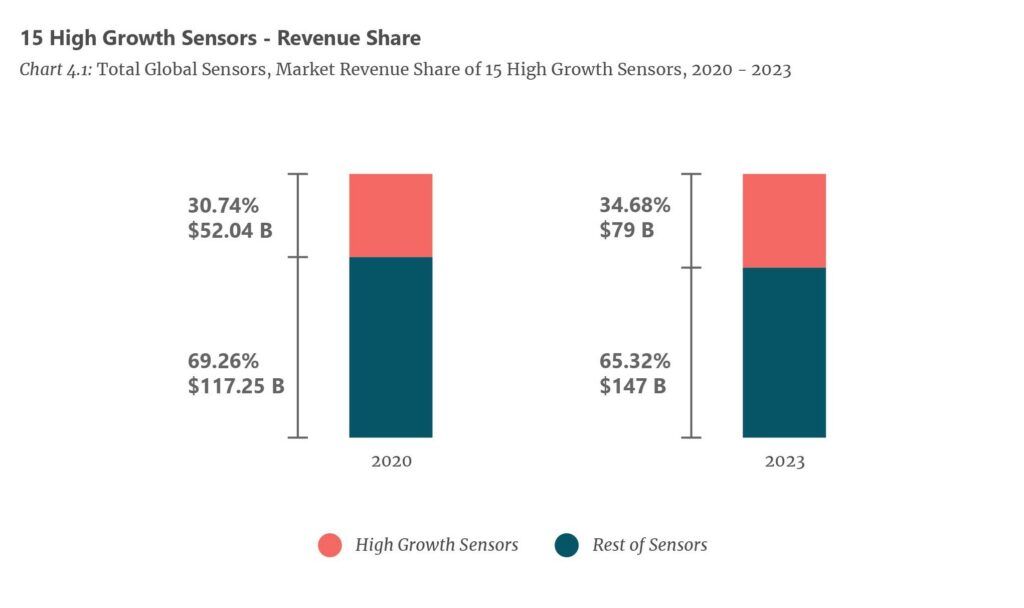
The high growth of 15 sensors is likely to boost their revenue share from 30.74% in 2020 to 34.68% in 2023.
Cumulative revenue growth
15 high growth sensors generated in 2020 cumulative revenue of $52B. Biosensors, touch, LiDAR, DAQ and rain sensors are the top five revenue generators which alone contributed $38.57B in 2020. The total cumulative revenue is estimated to grow to $79B in 2023 growing at a CAGR of 14.9%.

High growth spectrum by product type
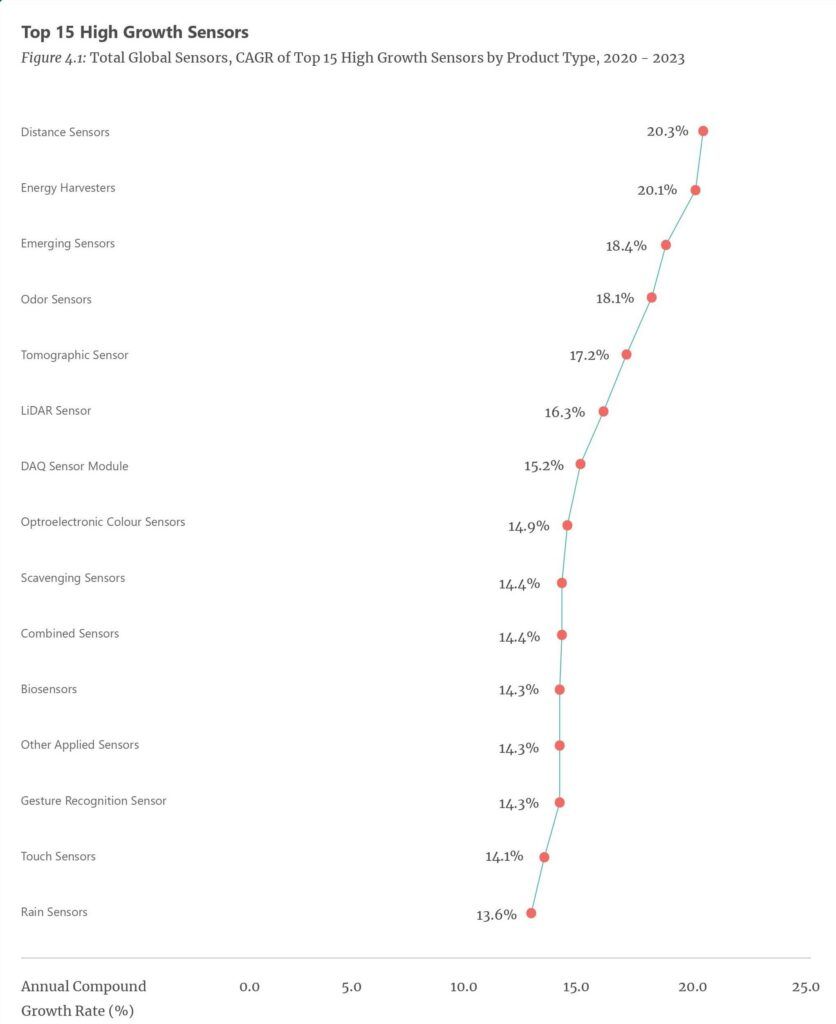
Total global sensors: Growth and revenue analysis of top 15 high growth sensors by product type
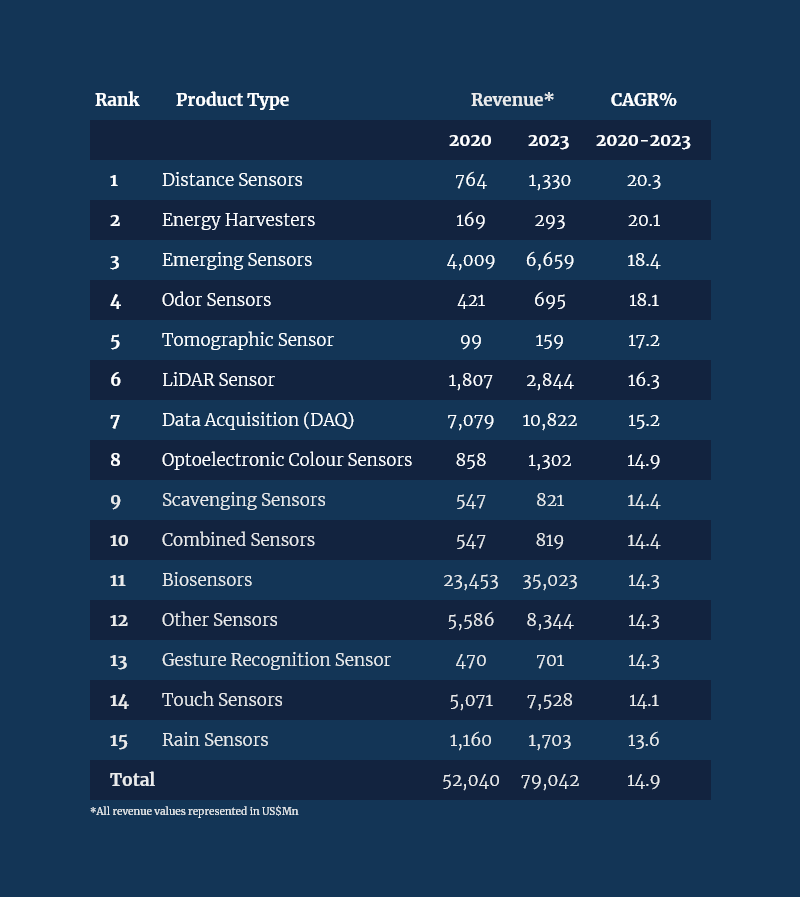
At the lowest ebb of growth at CAGR of 13.6% is rain sensor. Irrigation and farm applications are driving
growth of rain sensors. Rain sensor is integrated with flow sensors and moisture to actuate and control water supply to large organized agriculture and horticulture farms. Other applications include automotive (wiper), forestry, oceanography, shipping and environmental applications.
Biosensors are the largest revenue generator and its high growth is driven by shift to preventive health monitoring both in point of care and home diagnostic user segments. Biosensors cater to over 52 different diagnostic test types. At the height of growth ebb is distance sensors estimated to grow at CAGR of 20.3%.
This growth is driven by growing application landscape. Growing applications include assembly lines in automotive, aerospace, electronics, construction, and military. Its applications include measurement of distance, thickness, position, runout and profiling. They are based on multiple technologies like ultrasonic, infrared, optical, piezoelectric crystals and laser (LiDAR) for both short-range and long-range applications.
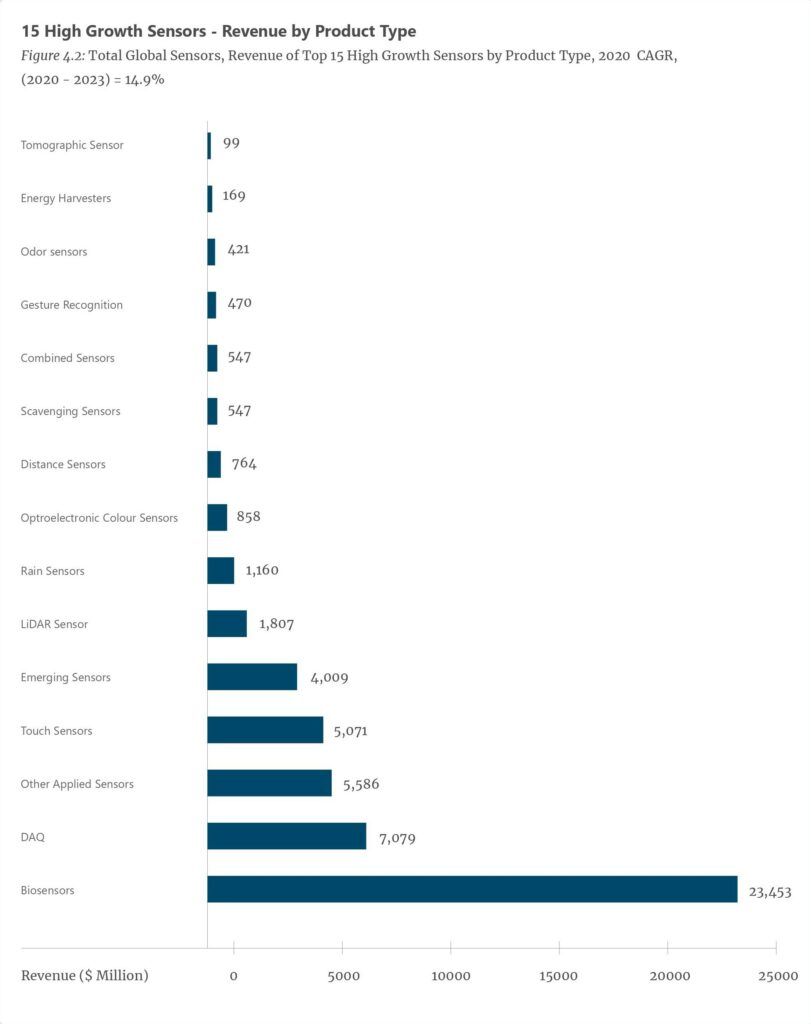
Top largest sensors
Another group of 15 identified as largest revenue generators with contribution of 79.88% of total revenue of sensors in 2020.
Growth drivers
The key reasons for large market size are:
- Monitoring basic most important parameters
- Largest installed base which requires periodic replacements
- System integration due trend for higher plant efficiency and control
- Technology upgradation of legacy systems like higher level automation and intelligence, installation of AI embedded sensors, IoT compatible sensors and remote connectivity, shift to sensors with wireless nodes, and smaller foot print.
- Expansion of user base and new industrial plants
- Shift to complete automation systems
- Development of combined sensors to simultaneously measuring two or more parameters
Market revenue share

Largest 15 sensors are likely to continue to dominate with revenue share of 79.88% in 2020 and 79.38% in 2023.
Cumulative revenue and growth
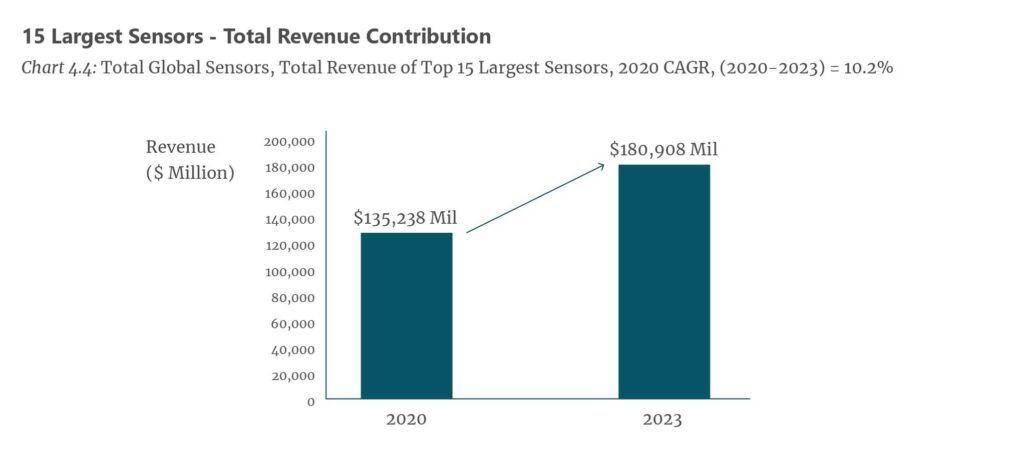
15 largest sensors are cumulatively largest revenue contributors by generating $135B revenue in 2020 which is estimated to increase to $180B in 2023.
Total global sensors: Growth and revenue analysis of 15 largest sensors by product type
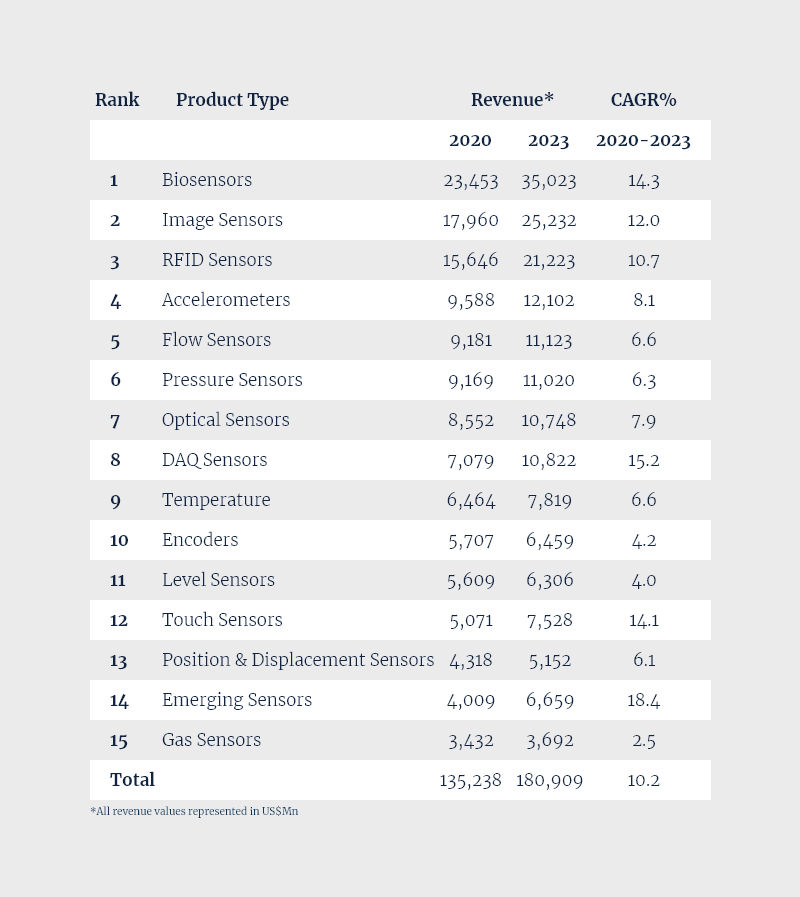
The top largest 15 sensors are estimated to grow at a CAGR ranging from 2.5% (gas sensors) to 15.2%
(DAQ) during the forecast period 2020-2023.
Image sensors, RFID sensors, accelerometers, biosensors and flow sensors are the top five revenue generators in the sensors market. These 5 top largest sensors alone generated $75.8B in 2020 which is estimated to increase to $104.7B in 2023. The Cumulative CAGR of these 5 Top sensors is 11.4% for the period 2020-2023.
At the lowest ebb of growth at CAGR of 2.5% is gas sensor which is used in multiple end-user markets like, oil & gas, chemicals, mining, power generation, building automation, HVAC, food processing , pharmaceuticals, healthcare and environmental.
Large revenue spectrum by product type
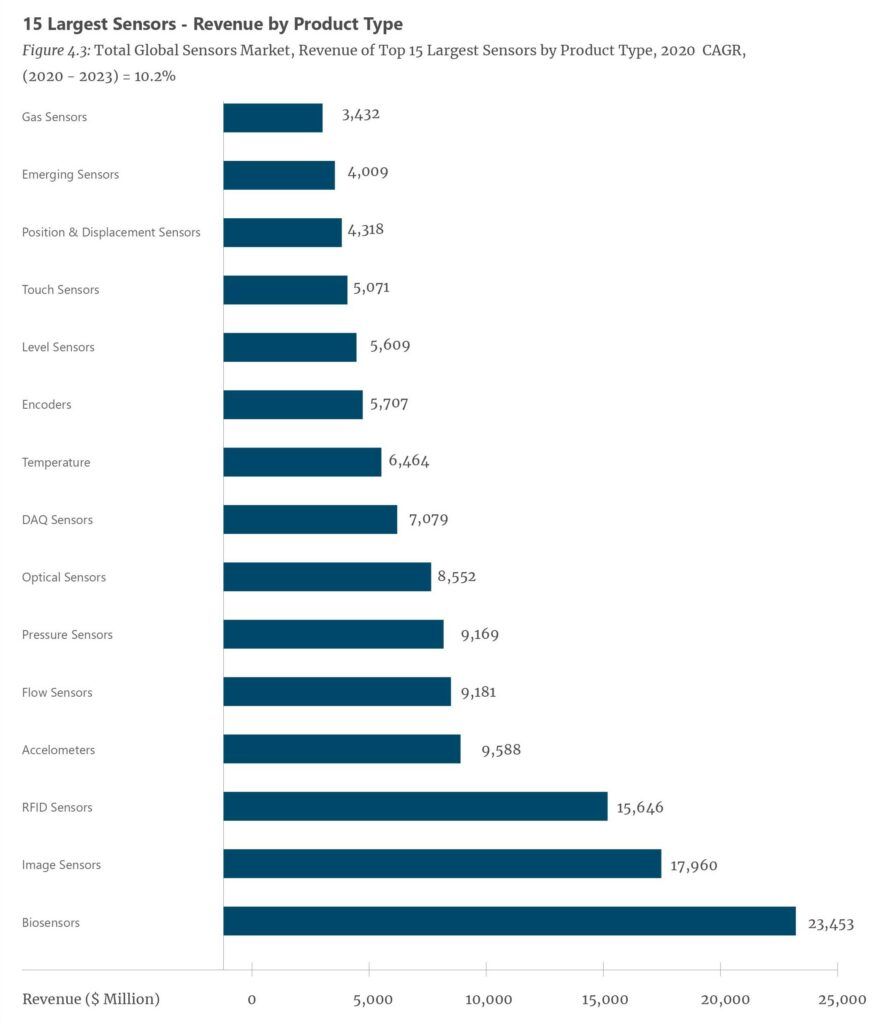
Biosensors is both largest revenue generator with revenue of $23.4B and its high growth of 14.3% CAGR is driven by shift to preventive health monitoring both in point of care and home diagnostic user segments. Biosensors cater to over 52 different diagnostic test types. There are number of different biosensors and the largest being glucose detection and monitoring.